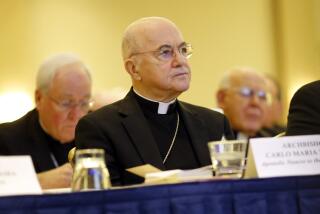A pope with a problem
This has been a tough Lent for the Roman Catholic Church. Its seemingly endless sexual abuse scandal finally has seeped into the papal apartments, and the Vatican’s response to this week’s revelations suggests that far too little has been learned from this squalid affair.
Until now, Pope Benedict XVI had seemed to be taking a far more forthright approach to the problem than his predecessor, John Paul II, most recently in a blistering “pastoral letter” to the entire Irish church.
This week, however, the New York Times published a pair of stories suggesting that Cardinal Joseph Ratzinger -- the future Pope Benedict -- participated in precisely the sort of secrecy and administrative negligence that has been at the root of this scandal.
Documents produced over the church’s objections in an American lawsuit show that the Vatican’s Congregation for the Doctrine of the Faith, which Ratzinger headed from 1981-2005, declined to defrock Father Lawrence C. Murphy, even though he molested at least 200 boys at a Wisconsin school for the deaf. In 1996, then-Milwaukee Archbishop Rembert G. Weakland twice wrote directly to Ratzinger requesting a trial aimed at defrocking Murphy, whose crimes were known to three successive Milwaukee prelates.
Ultimately, Ratzinger’s deputy, Cardinal Tarcisio Bertone, authorized a trial, then halted it after Murphy -- by then aging and in ill health -- wrote to Ratzinger appealing for leniency. As pope, Benedict has appointed Bertone to the Vatican’s two highest offices, secretary of State and Camerlengo. The last Italian cardinal to hold both posts simultaneously was Eugenio Pacelli, the future Pope Pius XII.
On Friday, the New York Times reported that, as archbishop of Munich, Ratzinger presided over a meeting that approved the return to parish work of an admitted pedophile, who went on to molest more children. A memo from that period also seems to show that the cardinal was “kept informed about the priest’s assignment.”
The Holy See’s reaction to both stories has been swift. An unsigned editorial this week in the Vatican newspaper L’Osservatore Romano attacked the New York Times by name, accusing the paper of willfully ignoring the “truth” of Ratzinger/Benedict’s record and of attempting “to instrumentalize, without any foundation in fact, horrible episodes and sorrowful events uncovered in some cases from decades ago.” The media, it continued, showed a “despicable intent of attacking, at whatever cost, Benedict XVI and his closest collaborators.”
Earlier in the week, New York’s archbishop, Timothy Dolan, used his blog to dismiss the New York Times’ reports and defend the pontiff’s record by arguing that authorities outside the church also are culpable. Stories about sexual abuse by priests were “fair” if “unending,” he wrote. But he condemned the media for portraying child sexual abuse “as a tragedy unique to the church alone. That, of course, is malarkey.”
Sadly, this latest everybody-is-responsible-so-nobody-is-to-blame defense is of a piece with a little-noticed section of Benedict’s letter to the Irish church in which he seemed to blame the crisis, in part, on “new and serious challenges to the faith arising from the rapid transformation and secularization of Irish society.”
So what happens now?
In all likelihood, nothing. Even if further revelations show that Benedict was malfeasantly negligent as a cardinal, there is no canonical mechanism that could force him to step down. The last pope to resign was Gregory XII in 1415, and he acted to heal a schism that had produced three claimants to the Throne of Peter.
What now seems likely is that the pontiff, who turns 83 next month, will spend the rest of his papacy dealing with the fallout of an ever-widening scandal. His situation will be precisely the one over which he assailed the Irish bishops in his recent letter: “It cannot be denied that some of you and your predecessors failed, at times grievously, to apply the long-established norms of canon law to the crime of child abuse. . . . I recognize how difficult it was to grasp the extent and complexity of the problem, to obtain reliable information and to make the right decisions in the light of conflicting expert advice. Nevertheless, it must be admitted that grave errors of judgment were made and failures of leadership occurred. All this has seriously undermined your credibility and effectiveness.”
More to Read
Sign up for Essential California
The most important California stories and recommendations in your inbox every morning.
You may occasionally receive promotional content from the Los Angeles Times.










